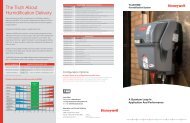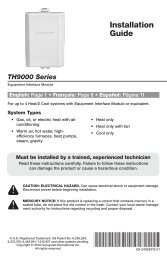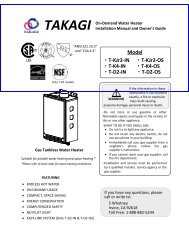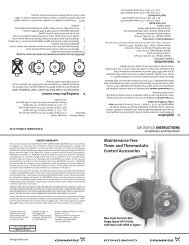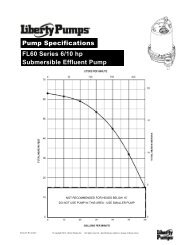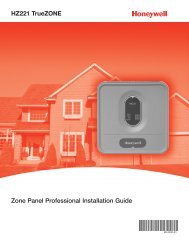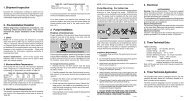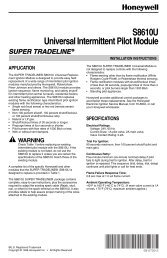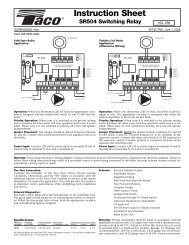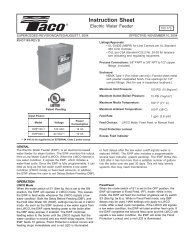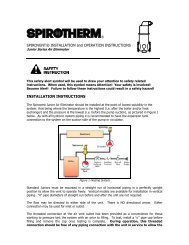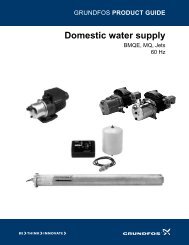Installation Manual Ascent II⢠Toilet Pumping System - PEX Universe
Installation Manual Ascent II⢠Toilet Pumping System - PEX Universe
Installation Manual Ascent II⢠Toilet Pumping System - PEX Universe
Create successful ePaper yourself
Turn your PDF publications into a flip-book with our unique Google optimized e-Paper software.
3-3 SYSTEM ASSEMBLY<br />
3-3-1 Schematics: Typical <strong>Installation</strong> Diagrams. Refer to these diagrams when needed during the assembly process. <strong>Installation</strong>s may<br />
vary per local plumbing and electrical codes. Also, discharge and vent pipe routing can vary per installation.<br />
3-3-2 Place the macerator in the desired location and connect all inlet and outlet waste piping to the unit. The non-inlet side of the tank<br />
should be towards the wall to ensure proper toilet placement.<br />
3-3-3 Assemble the toilet in accordance to the installation manual(s) provided with it. Be careful when tightening fasteners as to not crack<br />
the porcelain.<br />
3-3-4 To mount the toilet to a concrete floor, drill two holes approximately 2-1/4” deep with a 5/16” masonry drill bit. Insert plastic plugs<br />
into holes. If the floor is wood, bore a pilot hole with a ¼” drill bit.<br />
3-3-5 Place the toilet in front of the macerating tank and apply silicone grease to sealing lip of macerator. Then slide the discharge hub of<br />
the toilet into the rubber sealing ring of the macerator.<br />
3-3-6 Place the toilet over the holes in the floor. Slip the plastic china protectors over the lag screws ensure proper orientation. Tighten lag<br />
screws (do not over tighten) and snap plastic caps in place.<br />
3-3-7 Connect the water supply line to the fill valve, located directly below the flush lever, on the bottom of the toilet tank.<br />
3-4 CONNECTION TO THE DISCHARGE AND VENT FLANGES<br />
3-4-1 The Macerator has a PVC discharge flange with an integrated check valve that can be configured in a vertical or horizontal<br />
orientation. Standard 1” schedule 40 PVC pipe can be solvent welded directly to the flange. Excessive amounts of glue should be<br />
avoided. The check valve can be removed from the flange if required. Replacement flanges can be ordered.<br />
http://www.libertypumps.com/Service/ReplacementParts/<br />
3-4-2 A “full-port” ball or gate valve and a union should be installed in the discharge pipe to facilitate the removal of the macerator or to<br />
perform maintenance if required. In addition, a drain off point is also recommend to allow the discharge piping to be drained if<br />
required.<br />
3-4-3 The macerator is equipped with a PVC vent flange, which can be configured in a vertical or horizontal orientation. Standard 1-1/2”<br />
Schedule 40 PVC pipe can be solvent welded directly into the flange.<br />
3-4-4 The macerator must be vented to allow for proper toilet flush performance. Depending on the installation, the product should either<br />
be connected to the stack vent of the dwelling or vented (plumbed) directly outside.<br />
3-4-5 Do not use an air admittance valve or a mechanical spring-loaded venting device, as these devices are one-way valves. The air<br />
pressure in and outside the macerating pump unit must be equal, a “cheater” vent will obstruct the airflow in one direction.<br />
3-4-6 The Macerator is not designed to support the discharge and vent piping; proper pipe hangers are required.<br />
3-5 CONNECTION TO THE SOIL-STACK OR SEWER<br />
3-5-1 The macerator has a shut-off head of 36 feet. All frictional losses from horizontal runs and elbows need to be accounted for. The<br />
minimum flow rate for 1” PVC sch. 40 pipe is 5 gal/min compared to 3 gal/min for ¾” PVC pipe. If you require a vertical lift, it should<br />
precede any “horizontal” run and should commence as near as possible to the discharge of the macerator. Once you have started<br />
the horizontal run, you may not change directions in a vertical manner.<br />
NOTE: Friction losses from horizontal runs without ¼” per foot pitch will reduce the amount of vertical lift<br />
the system is capable of handling. See sections 3-5-2 and 3-5-3. Consult factory for proper sizing if you<br />
have long runs or multiple elbows. Phone: 1-800-543-2550.<br />
3-5-2 The discharge piping can be made from ¾” or 1” diameter CPVC or PVC pipe. Use long turn bends and not elbows where possible.<br />
The connection to the soil-stack or sewer pipe should be made with an approved wye fitting.<br />
©Copyright 2011 Liberty Pumps Inc. All rights reserved. 6



